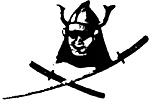 After receiving the Newsletter for over three years I
cannot once remember reading any article vaguely associated
with that most interesting (to me anyway!) of warlike states -
Ancient or Mediaeval Japan. The following information and ideas
I thus thought might be of interest to many otherwise
uninformed or previously uninterested readers of the
Newsletter.
After receiving the Newsletter for over three years I
cannot once remember reading any article vaguely associated
with that most interesting (to me anyway!) of warlike states -
Ancient or Mediaeval Japan. The following information and ideas
I thus thought might be of interest to many otherwise
uninformed or previously uninterested readers of the
Newsletter.
For wargaming purposes and military enthusiasts in general the warlike culture and institutions of Ancient Japan hold a wealth of interest which grows with prolonged contact. The earliest known Japanese armour was known as 'Tanko' armour and was very similar to the advanced plate armour worn in Europe, in the early 15th, late 14th centuries, in its basic form - that is the hooped skirt armour and lobster type shoulder guards and helmet with the typical tubular arm guards and the iron cuirass. In the late 15th century, however, under Asiatic influence, a new type of armour the 'Keiko' or lamellar armour (consisting of many small plates laced with leather) often seen on Greek warriors of an earlier period - in fact the Keiko could be directly traced back in this direction.
By the 11th century the 'Yoroi' the well known armour of the mounted soldier, examples of which can be seen in such films as the "Throne of Blood" (Japanese Macbeth) and the "Seven Samurai" and indeed many more, had reached its full development. At this period - the Kamakura Period - from around 1186-1333 warfare consisted of many mounted samurai supported by small groups of infantrymen in fast moving encounters.
For wargaming this could, with very few figures say 5 or 6 mounted and 20 or so infantry for each side, make a very interesting battle. The main weapon of the Samurai was the longbow while the foot soldier carried the spear and both also wore various swords and dirks. This.period in fact would make a good personalised wargame as Samurai rivalry was much akin to mediaeval single combat.
To keep it as short as possible, however, perhaps the most interesting period for the wargamer is the MomoyAma Period (1573-1602) the 'Sengoku jidai' - Age of Battles. The Samurai were by now fighting on foot as well as on horse with both sword, spear and bow and in battle they either led the attack on horse or supported the groups of well disciplined infantry who now had appeared as a main factor on the battlefield. Just as in Europe the musket (matchlock) was now in use with many companies of infantry as well as the spear and bow although I would have said that it should be given the same, or even less, effect on the battlefield as its European counterpart.
Some idea of the massive armies then in use is given by the Battle of Sekigahara where Tokugawa Iyeyasu with 80,000 men defeated Hideycrils 130,000 men in 1600 leaving 30,000 dead on the battlefield. A point which many people are often surprised to here is that Japanese armour, especially of this period, was bullet-proof, the deep test marks in many Yoroi are proof of this fact.
The obvious snag with all this is "Where do I get the figures from?" Unfortunately I know of no firm making anything smaller than 54mm Japanese figures. Up till now, however, I have found that with a little patience the Airfix "Robin Hood" and "Sheriff of Nottingham" will convert to presentable Samurai or any other Japanese troops, in bunches of 10 or so these figures look quite good.
Should you decide to print this the explanations given are really rather brief so if anyone is interested further the small bibliography below gives a range of some of the best books on the subject.
- "The Armour Book in Honcho-Gunkiko" by Arai Hakuseki, edited by H.Russell Robinson,
London 1964.
"History of Japanese Costume" by Josiah Condon (Vol II - Armour) (Hard to come by.)
Any of the books by H. Russell Robinson especially if it is available "A Short History of Japanese Armour" which is a Ministry of Public Building and Works publication and is obtainable probably from any of the large National Museums or H.M. Stationary Office. "A History of Warfare" by Montgomery of Alamein published by Collins also has a good article on Japanese warfare, although it does not do justice ot the tactical and atrtegic abilities of the later commanders.
Back to Table of Contents -- Wargamer's Newsletter # 119
To Wargamer's Newsletter List of Issues
To MagWeb Master Magazine List
© Copyright 1971 by Donald Featherstone.
This article appears in MagWeb.com (Magazine Web) on the Internet World Wide Web.
Other articles from military history and related magazines are available at http://www.magweb.com